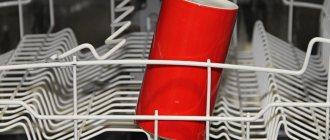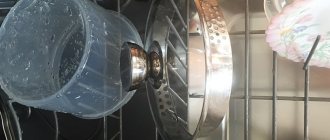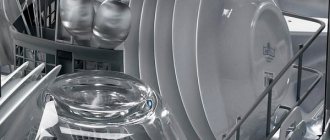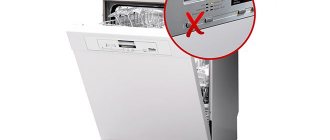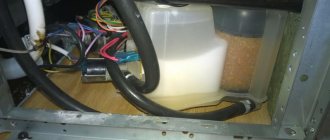The dishwasher saves not only the user’s personal time, but also water. Considering the current cost of the resource, we must recognize the feasibility of using this kitchen appliance, because... it uses very little water compared to manual washing.
- What is the water consumption of a dishwasher?
- How savings are achieved
- Comparison with hand washing
- Calculation of savings in money
- Expert advice
- Dishwasher catalog with reviews
What does it depend on?
If we consider the level of water consumption, according to this parameter there are 3 classes of PMM machines:
- highly economical;
- moderately economical;
- uneconomical.
For ease of understanding, each model is assigned an efficiency class, expressed in the form of letters - from “A” to “G”.
In the model range of well-known manufacturers, for example, Bosch, Candy, Electrolux, there are only highly economical PMMs, the classes of which are A - C. Uneconomical equipment is no longer produced in the EU countries, and their import is prohibited.
There is no specific standard for how much water and light a dishwasher requires.
What does consumption depend on:
- design features of the equipment;
- additional functions.
Conventionally, there are 3 classes of devices:
- household (both full-size and narrow) – 9 – 14 l;
- compact – 6.5 – 10 l;
- professional (as a rule, installed in public catering outlets with large throughput) – 20 – 25 liters.
Figures shown may vary depending on model. For example, there are dishwashers with a “half load” option, which reduces water consumption by 20 - 30%.
Another, no less useful function is “intelligent assessment”, when the equipment independently determines the required amount of liquid without compromising quality. As a rule, such functionality is inherent in premium models.
Expert advice
When choosing a dishwasher in a store, pay attention to such indicators as:
- washing class;
- Economy mode and half load option available.
The operation of class A appliances is characterized by the lowest water consumption. According to this indicator (from A to G), dishwashers are divided into:
- economical;
- average degree of efficiency;
- low-cost.
In recent years, kitchen appliance manufacturers have been producing devices that use water resources as efficiently as possible.
Special modes will help reduce the amount of water consumed:
- economical;
- for light contamination;
- half load.
Remember also that proper placement of dishes will ensure ideal washing results and make it possible to reduce water consumption. Recommendations for the distribution of kitchen utensils in the washing compartment can be found in the user manual.
There are many benefits of using a dishwasher in your home. In addition to saving time and the ability to go about their business, the user receives a reduction in water consumption. The technology uses an expensive resource efficiently and repeatedly.
How much H2O is lost in one wash?
Water consumption directly depends on the capacity of the device.
Regular (narrow, full-size)
These are middle-class machines, where a narrow one can wash 9 sets of dishes in 1 cycle, and a full-size one can wash 10-14.
The average consumption for such equipment ranges from 9 to 14 liters . In this case, we are talking about cold water, since PMMs are often connected to cold water supply in order to save resources. That is, to wash 9 sets of dishes, the machine needs only 9 liters of water - this is quite economical.
The peculiarity is how this technique works. The PMM collects water once and uses it to wash dishes. In this case, the water passes through the cleaning filter during the cycle. Towards the end of the procedure, the technician again takes water to rinse the dishes and completes the cycle with a final rinse.
The cost-effectiveness of popular PMMs priced up to 40,000 rubles is presented in the table:
Economical
Dishwashers are produced that spend only 7 liters per cycle . Usually these are premium segment models or compact PMMs. Low water consumption does not always mean low capacity of equipment.
There are models with a large load but minimal consumption, but they are expensive. Example - Siemens SN 236100 ME, whose water consumption is 6.5 liters.
This is a full-size appliance, designed for 13 sets of dishes, with an energy consumption class of A++. As a rule, economical models require 40% less water than conventional ones.
Compact PMMs with a small capacity designed for 6 to 8 sets of dishes are also called economical. They consume the same amount of water as the narrow versions - 6.5 - 9 liters. It turns out that their level of water consumption is similar to large dishwashers, but they are capable of washing much less dishes.
Comparison with hand washing
When washing by hand, in order to wash the amount of dishes that would fit in the PMM, you will need 70 - 100 liters of water, both hot and cold.
That is, a machine with a flow rate of 7 - 14 liters requires 10 times less water.
Approximate calculation:
- Dishwasher. 14 l x 360 (days) = 5040 l (cold water);
- hand wash. 70 l x 360 = 25200 l (12000 – cold, 13200 – hot).
The price of 1 cubic meter of water depends on the region of residence. For example, a cold one costs 30 rubles, a hot one – 100.
It turns out:
- PMM. 5040 x 30 = 151.2 rubles;
- manual. 12 x 30 + 13.2 x 100 = 1680 rubles.
If you take into account water consumption, then a dishwasher is much more economical than washing by hand.
How savings are achieved
The dishwasher uses water more economically thanks to the following operating features:
- The water in the device is reused many times, purified using filters.
- Water is sprayed under high pressure.
Water in the PMM is used at three stages:
- pre-spraying;
- main washing cycle;
- rinsing.
After completing the first operation, the machine does not drain the water into the sewer, but passes it through a filtration system and reuses it. After washing dirty dishes, the equipment partially drains the liquid and adds a fresh portion from the water supply to the remainder.
Expert opinion
I work in the household appliance repair industry. Extensive experience in restoring washing machines and dishwashers.
Ask a Question
Thanks to the high flow rate of water from the sprinklers, the quality of washing dishes is improved and the process is accelerated, as well as resource consumption is reduced.
How much electricity does the PMM consume in 1 cycle?
The energy efficiency of working units and the technical solutions used by the manufacturer determine the cost-effectiveness of the PMM.
A lot of light is spent on running the heating element , circulation pump and pump.
The heating element that heats the water consumes the most; in second place is the element that ensures the drying operation. In machines without hot drying, the consumption is lower.
There are dishwashers with convection drying. They do not have a second heating element or fan, which reduces energy consumption by 40%.
For the most part, light consumption depends on the capacity of the tank containing water and its temperature. That is, a smaller tank means lower energy consumption.
Before buying a PMM, it is worth studying its energy efficiency in advance, which is indicated in the technical data sheet.
This is a line called “energy class”, where a specific letter is indicated:
- A – 0.7 – 1.7 kW;
- B – 1.08 – 1.1 kW;
- C – no more than 1.5 kW;
- D, E (nowadays they are becoming less common) – up to 2 kW;
- F, G (non-economical models) – 2.5 – 2.7 kW.
If the manufacturer was able to achieve a value below 0.7 kW, then a “+” sign is added to the figure.
Quality of dishwashing - simple conclusions from practice:
- As a rule, you wash cups and spoons at a water temperature not exceeding 50 degrees. Is this temperature optimal? Of course not. Sometimes grease remains on the dishes, and microbes feel quite tolerable at this temperature. Is it possible to wash dishes by hand at 70 degrees? You can't because you risk getting burned. And “smart” technology copes with this task “excellently”.
- Add to this the effect of detergents on the skin of your hands. Purchasing expensive natural remedies only partly solves the problem. And the use of mustard powder and other “grandmother’s” products significantly reduces the quality of washing. When using a dishwasher, you do not come into contact with detergents.
- Now about water treatment. Everyone knows that hard water removes stains on dishes and kitchen utensils much worse than soft water. When washing dishes by hand, you cannot influence the situation in any way. A “dishwasher” is a completely different matter. Before being used to wash dishes, the water passes through a softening device.
Top 3 economical models
Let's consider models that allow you to save water and energy resources.
Beko DTC 36610 W
Freestanding compact model with touch controls. It can wash up to 6 sets of dishes, and consumes 6.5 liters of water per cycle . Energy efficiency class – A+.
The manufacturer has increased the safety of the equipment by installing the “WaterSafe+” system - blocking the water supply in the event of a leak.
There are all the necessary programs, for example, quick washing, working with glass, economical mode (water is heated to a temperature of +50 degrees).
The informative display will show how much time is left until the end of the cycle and display the amount of salt for washing. The only negative is that due to its compact size, the maximum number of sets of dishes is no more than 6 (for a large family this may seem small). The current price can be viewed here.
Bosch SPS 25CI07 E
Compared to the previous version, the larger and more spacious model is capable of washing 9 sets of dishes in 1 cycle , consuming the same amount of water.
This PMM is narrow, so it will not take up much free space. The GlassProtect system allows you to wash even fragile glass utensils.
The “ActiveWater” function and the loading sensor are responsible for efficiency - the machine itself will determine how much water and light it needs. Additionally, the half-load option speaks in favor of efficiency. You can program the operation of the machine in advance by setting a timer.
The cost of the machine is from 35,000 rubles.
Siemens SN 636X03 ME
Full-size equipment, protected from leaks.
Number of programs – 6. Energy consumption class – A++ (0.93 kW/h), water consumption – 9.5 l . In 1 cycle the machine can wash 14 sets of dishes.
The model can safely be called economical, since there is a half-load option and an eco mode (lowering the water temperature for not too dirty dishes). The cost of the device is from 38,000 rubles.
PMM can easily cope with heavily soiled items, for which it pre-rinses them.
Advantages of dishwashers
The general design of all models is similar: two or three baskets for dishes, various trays for cutlery. All modern models are equipped with a heating element.
Thus, the presence or absence of hot water will not affect the result in any way.
This can already be considered a beneficial advantage, because the tariff for cold water is several times lower.
Dishwashers have filter elements
, through which the same volume of water is used several times. Achieving such a result manually is very difficult. Some models are equipped with a “half load” or “auto mode” function; the washing cycle may not change in time, but the water consumption will decrease by about a quarter.
In addition, there is also the coolness of water consumption
cars:
- highly economical;
- medium-economical;
- low-economical.
According to standards, the class is marked with the letters A, B and C, respectively. Most models, of course, go under class “A”, but when choosing a suitable car for your home you should pay attention to this parameter.
Does the device save resources?
Savings make sense if meters are installed for the H2O supply . Cost-effectiveness will be considered using the example of the Siemens SN 66M094 model, designed for 14 sets of dishes.
This is 63 items, including plates, cups, pots, cutting board and cutlery. She will wash them for 3 hours (intensive mode), and will take only 10 liters of water.
If you wash at least half of these 63 items, but by hand, you will need, on average, 20 minutes and 43 liters of water (hot and cold). In terms of liquid resources, the savings are obvious.
To evaluate the real savings, you should also take into account the costs of light and cleaning tablets. It turns out that electricity is wasted, but water is saved. In general, the costs for manual and machine washing are approximately the same.
Reducing water consumption during cleaning and washing
Since modern housewives rarely wash by hand, you should pay attention to the proper organization of washing machines. Carefully read the instructions for the device to find out everything about resource costs. Don't use an extra rinse unless you want to pay more. Choose a program that will reduce not only solution consumption, but also electricity. Also use the following recommendations:
- Treat the most contaminated areas with laundry detergents in advance. With this method, even a quick wash cycle will allow you to thoroughly clean your laundry;
- Do not turn on the washing machine if the drum is lightly loaded. Try to use the equipment only at maximum load;
- choose programs with fast mode, and also turn off additional rinsing;
- Buy washing powders and fabric softeners that are easily washed out of fabrics.
When cleaning, it is enough to use the tap only when it is really necessary. For example, if you have filled a bucket with liquid, turn the switch until the next use.
Cost Feedback from Consumers
Users note that dishwashers are convenient for washing large dishes and kitchen utensils.
The main thing that users note is saving time , not water.
Yes, there are inconveniences associated with the need to “accumulate” dirty dishes before putting them in the washing machine.
For this reason, buying an appliance for an apartment is questionable for those people who have, for example, 2 cups and 2 plates in circulation; it is easier for them to wash the dishes by hand. But, the equipment will be a godsend for large families who like to gather with guests.
As for saving electricity, you can program your dishwasher using a timer to run at night when a reduced rate is in effect.
There is another opinion regarding the price of service. We are talking about special tablets for washing dishes. Branded consumables sometimes cost a fortune if the equipment is used frequently , but they are easily replaced with simpler and cheaper detergents.
In general, the main advantage of using a dishwasher, according to users, is saving time, the only irreplaceable resource.
Detailed reviews and discussion can be read here and here.
Using the toilet
On average, a toilet tank holds 10-15 liters of water, which at first glance does not seem to be too much compared to a shower. But in thinking this way, we don't take into account the fact that, unlike brushing our teeth or taking a shower, we use the toilet more than twice a day. In addition to using it for its intended purpose, people often use the toilet to flush out leftover food, drain dirty water after wet cleaning the house, or even to throw out small garbage. As a result, water consumption from using the toilet increases to 50 liters per day.
Additional advantages of dishwashing equipment:
- In modern machine models, it is possible to wash dishes at a temperature of 90 degrees, which actually means sterilizing them. This is especially true for families with small children.
- Like washing machines, “dishwashers” have a favorable cycle cost ratio in relation to the number of dirty dishes. For a large family, it is more profitable to purchase a unit with a larger capacity. It's much more profitable.
- If you use dishwashers in regions with hard water, this is your only chance to wash glassware without streaks and limescale stains.



